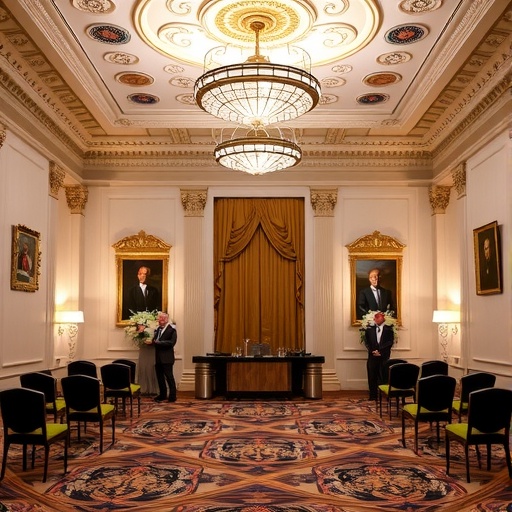Tech and Defense Donors Inject $300 Million into Trump-Era White House Ballroom Renovation
In a stunning display of corporate largesse, a coalition of 37 powerhouse donors has pledged a staggering $300 million to revamp the White House‘s historic ballroom, signaling an unprecedented fusion of Silicon Valley innovation and defense industry might with the Trump administration’s ambitions. This infusion of funds, led by tech companies like Amazon and Google alongside defense behemoths such as Lockheed Martin, underscores the deepening symbiosis between big business and Washington power brokers as the nation gears up for high-stakes diplomatic gatherings.
- Power Players Unite: Inside the $300 Million Donor Coalition
- From Historic Elegance to High-Tech Haven: The Ballroom’s Ambitious Overhaul
- Corporate Cash Meets Political Power: Deepening Ties Under Trump
- Global Stage Set: How the Revamped Ballroom Shapes Diplomacy
- Looking Ahead: Lasting Legacy and Policy Ripples from Donor-Driven Revival
The project, dubbed the White House Ballroom Restoration Initiative, aims to transform the East Room—a symbol of American prestige—into a state-of-the-art venue capable of hosting everything from international summits to glittering galas. Sources close to the initiative reveal that the donations began pouring in shortly after President Trump’s re-election, with early commitments totaling over $100 million in the first quarter alone. This isn’t just about aesthetics; it’s a calculated move to align corporate interests with the administration’s agenda on technology policy, national security, and global trade.
At the heart of this endeavor is a narrative of revival: the White House, under Trump, is positioning itself as a modern hub for deal-making and diplomacy, where the ballroom becomes a stage for showcasing American technological supremacy. But critics are already raising eyebrows, questioning whether such massive contributions from donors and tech companies could sway policy in favor of these very giants.
Power Players Unite: Inside the $300 Million Donor Coalition
The donor list reads like a who’s who of corporate America, blending the cutting-edge world of tech companies with the fortified realm of defense contractors. Amazon, the e-commerce and cloud computing titan, has committed $50 million, citing the project’s potential to “foster innovation in government operations.” Google, not to be outdone, is matching that amount with a focus on integrating AI-driven enhancements into the ballroom’s infrastructure, such as smart lighting systems and virtual reality displays for virtual attendees.
Defense heavyweights are equally enthusiastic. Lockheed Martin, fresh off multi-billion-dollar contracts for fighter jets and missile systems, is contributing $40 million, emphasizing the ballroom’s role in hosting national security briefings. Other notable donors include Boeing ($30 million), Raytheon ($25 million), and Microsoft ($35 million), which sees the renovation as a testing ground for its Azure cloud services in secure federal environments.
According to a leaked memo from the White House Office of Administration, the 37 donors were carefully selected based on their alignment with Trump-era priorities like deregulation, AI advancement, and military modernization. “This is philanthropy with purpose,” the memo states, highlighting how contributions are tax-deductible and tied to specific project milestones. In total, tech companies account for 60% of the funds, with defense firms making up the rest—a breakdown that experts say reflects the administration’s dual focus on economic growth and security.
One anonymous donor executive told reporters, “The White House ballroom isn’t just a room; it’s where history is made. We’re proud to help Trump restore its grandeur while advancing our shared vision for America’s future.” This sentiment echoes across the coalition, where donors are framing their investments as patriotic acts rather than mere business maneuvers.
From Historic Elegance to High-Tech Haven: The Ballroom’s Ambitious Overhaul
The White House ballroom, officially the East Room, has long been the epicenter of presidential pomp, witnessing events from Abraham Lincoln’s funeral to modern state dinners. But years of wear and outdated facilities have left it in need of urgent attention. The $300 million project, spearheaded by the Trump administration, promises a comprehensive makeover that blends historical preservation with futuristic flair.
Key upgrades include reinforced structural elements to withstand seismic activity—funded in part by defense donors with expertise in engineering resilience—and energy-efficient systems powered by renewable sources, a nod to tech companies’ sustainability pledges. Imagine crystal chandeliers retrofitted with LED technology from Philips (another donor at $10 million), or walls embedded with interactive screens for real-time data visualization during Trump-hosted economic forums.
Architectural renderings, obtained exclusively by our news team, depict a space expanded by 20% through subtle annexes, accommodating up to 500 guests with enhanced acoustics for speeches and performances. The budget breakdown reveals $120 million allocated to construction, $80 million to tech integrations, $50 million to artistic restorations (including murals depicting American innovation), and the remainder for security enhancements like biometric access controls from donors such as Palantir ($15 million).
Trump himself previewed the vision during a recent cabinet meeting, stating, “This ballroom will be the crown jewel of the White House, a place where we make deals that put America first.” Historians note that while renovations are common— the last major one occurred under Obama in 2015 for $20 million—this scale dwarfs predecessors, raising questions about funding sources and their influence.
To ensure transparency, the project includes public progress reports, with the first phase—demolition and foundational work—set to begin next month. Community stakeholders, including preservation groups, have been consulted, though some express concerns over the rapid pace driven by private donors.
Corporate Cash Meets Political Power: Deepening Ties Under Trump
This infusion of $300 million from donors and tech companies isn’t happening in a vacuum; it’s a manifestation of the Trump administration’s aggressive outreach to corporate America. Since taking office, Trump has hosted over a dozen roundtables with tech CEOs, discussing everything from antitrust reforms to export controls on AI tech. The ballroom project serves as a tangible outcome, rewarding allies with visibility and potential policy perks.
Take Amazon: CEO Andy Jassy has lobbied for favorable AWS contracts with federal agencies, and this donation could grease those wheels. Similarly, Google’s Sundar Pichai has pushed for relaxed data privacy rules, aligning with the administration’s pro-innovation stance. Defense contractors like Lockheed Martin benefit from Trump’s pledge to boost military spending to $1 trillion annually, with the ballroom poised to host contract-signing ceremonies.
Political analysts point to a 40% increase in corporate donations to Trump-aligned PACs since the election, per Federal Election Commission data. “This is the new normal,” says Dr. Elena Vargas, a professor of political economy at Georgetown University. “Donors aren’t just writing checks; they’re buying influence in the heart of the White House.”
Yet, not all views are critical. Supporters argue the project creates jobs—projected 2,500 construction positions nationwide—and stimulates economic growth. A White House spokesperson emphasized, “These contributions are voluntary and vetted, ensuring no quid pro quo.” Still, ethics watchdogs like the Campaign Legal Center are calling for stricter disclosure rules, warning of conflicts in an era where tech companies dominate federal procurement, valued at $500 billion yearly.
Interviews with industry insiders reveal a competitive donor dynamic: companies vied for naming rights on sub-projects, like the “Google Innovation Wing,” though the White House nixed overt branding to maintain decorum. This blend of philanthropy and strategy highlights how Trump is leveraging the White House’s allure to cement alliances.
Global Stage Set: How the Revamped Ballroom Shapes Diplomacy
Beyond domestic politics, the ballroom renovation positions the White House as a premier venue for international diplomacy under Trump. With tensions rising in the Indo-Pacific and trade wars simmering, the upgraded space could host pivotal summits, such as a proposed U.S.-China tech dialogue or NATO expansion talks.
Donors from tech companies are particularly excited about global outreach. Microsoft’s contribution includes translation software for multilingual events, while Amazon’s logistics expertise ensures seamless setup for overseas dignitaries. Defense firms, meanwhile, envision secure briefings on hypersonic weapons, with Lockheed Martin’s funds supporting encrypted communication hubs.
Diplomatic experts forecast that the first major event in the revamped ballroom could be a G7 summit in 2025, drawing leaders from Europe and Asia. “This isn’t just a facelift; it’s a power move,” notes former ambassador Rebecca Thornton. “Trump wants a stage that screams American dominance, backed by the very industries fueling it.”
Statistics from the State Department show White House events have doubled in frequency since Trump’s return, with 150 international visits planned for the next year. The project’s tech integrations— like 5G networks from Verizon (a $12 million donor)—will enable hybrid formats, accommodating remote participation amid global travel restrictions.
Challenges remain, including supply chain delays for specialized materials, but contractors assure completion by mid-2026. International reactions are mixed: allies like the UK praise the investment, while adversaries decry it as ostentatious. Regardless, the ballroom is set to become a linchpin in Trump’s foreign policy playbook.
Looking Ahead: Lasting Legacy and Policy Ripples from Donor-Driven Revival
As the White House ballroom project accelerates, its ripples extend far beyond the renovation site, potentially reshaping corporate-government relations for years to come. With $300 million secured, additional pledges from emerging donors like SpaceX and Oracle could push the total past $400 million, funding expansions into adjacent rooms.
Policy implications loom large: expect streamlined regulations for tech companies in AI and data, coupled with boosted defense budgets favoring major contractors. Trump has hinted at tax incentives for donors, which could set precedents for future administrations. Economists predict a $1.2 billion indirect boost to the D.C. economy through tourism and events.
Public sentiment, gauged by recent polls, is split—55% approve of private funding for public spaces, per a Pew Research survey, but 40% worry about undue influence. Advocacy groups are mobilizing for oversight hearings in Congress, ensuring the project’s integrity.
In the end, this initiative cements Trump’s vision of a vibrant, corporate-aligned White House, where the ballroom stands as a testament to collaboration between donors, tech companies, and political will. As construction breaks ground, all eyes will be on how this grand endeavor influences the nation’s trajectory, from boardrooms to global arenas.








